Abstract
The utilization of crop straw resources has been highly emphasized by governments and academia in recent decades. The growing importance of straw decomposition in the wheat-maize rotation system and the remarkable diversity of accumulated information on this topic inspired us to quantitatively explore variations in the outcomes of individual studies. We conducted a data analysis of 46 experimental studies reporting the effects of agronomic measures on the straw decomposition rates of wheat (14 studies) and maize (38 studies). Statistical results showed that maize straw crushed and buried in soil with turn-over or rotary tillage can significantly increase straw decomposition rates. Further, with the increase in nitrogen input and straw burial depth in the soil, the maize straw decomposition rate increased significantly, while the amount of straw return showed the opposite trend. Among all agronomic measures in this research, burial depth has demonstrated a significant positive effect on the wheat straw decomposition rate. The random forest analysis identified decomposition time as the most important predictor of straw decomposition rates for wheat and maize. In addition, some agronomic measures and straw decomposition time jointly affect the decomposition rate of straw. In general, agronomic measures are effective factors in controlling straw decomposition in a wheat-maize rotation system.
1. Introduction
Winter wheat and summer maize are China’s main food and feed crops, which play a strategically fundamental role in achieving food security. According to statistics departments, the total annual output of various crop straw exceeds 1 billion tons in China, accounting for about 30% of the world’s total straw production [1]. For the sustainable development of agriculture, straw return has always been a major challenge encountered not only in China, but also among other western developed countries, such as America and Japan [2,3,4]. Numerous studies have demonstrated that straw return effectively improves soil physical and chemical properties, increases the organic matter and water content of the soil [5,6,7,8,9], alleviates soil degradation in intensive agricultural areas [10], and reduces atmospheric pollution caused by straw burning [11]. However, other studies have reported that crop straw retention in the soil led to a reduced emergence rate and prevented crop growth in the next season due to the failure to harmonize the requirements of nutrients between crop and soil microorganisms during the straw decomposition process [12,13].
The straw decomposition rate is an important index for straw return. Many studies have shown that straw return contributes to improving the emergence rate of crops, reducing diseases and pests, and promoting crop yield [6,14,15,16,17,18]. Ma et al. [6] demonstrated that the decomposition rate of crushed maize straw was relatively faster than that of whole straw at the initial 60 days but gradually reduced in the later stage, and after one year, there was no difference between crushed and whole straws. In comparison, Zheng et al. [19] revealed that crushing maize straws at 2 cm to 6 cm can promote straw decomposition. Wu et al. [20] exhibited that the decomposition rate of wheat straw gradually decreased with the increase in straw consumption, and Kuang Enjun et al. [21] also found that the decomposition rate accelerated with reduced maize straw addition. Furthermore, deep plowing and turn-over were shown to be conducive to the rapid decomposition of straw but have no effects on the final straw decomposition rate [14]. Zhang Yu et al. [22] also found that the sequence of maize straw decomposition rate under tillage methods was turn-over > rotary tillage > no-plowing. Additionally, different straw burial depths have different effects on straw decomposition and microbial diversity [1]. Although it is common practice to apply nitrogen fertilizer during straw return [23,24,25], Chen et al. illustrated that the maize straw decomposition rate did not change with the increase of nitrogen input [26], contrary to the results of Pang et al. [27]. Notably, the effects of all agronomic measures are inseparable from straw decomposition time [25].
The characteristics of straw decomposition have been well documented, but there remains considerable uncertainty regarding the potential response of various agronomic measures. Therefore, this research was an aggregation of national data regarding the straw return of maize or wheat in China, which can provide more representative data to quantitatively assess the effects of these agronomic measures on the straw decomposition of wheat and maize, including straw type, with plastic film mulched or not, covering ground or being buried in soil, burial depth, the amount of nitrogen input and its decomposition time, etc. The aim of this research was to verify the effects of widely used agronomic measures on the straw decomposition of wheat and maize. The research results can not only provide a theoretical basis for China’s wheat-maize rotation system and the practice of straw return but also provide new ideas for promoting the development of clean agricultural production in the world.
2. Database and Methods
2.1. Literature Retrieval
The literature focused on the “straw decomposition of wheat and maize in China” from sources such as CNKI (https://www.cnki.net/, accessed on 30 March 2022) and Web of Science (http://wokinfo.com/, accessed on 30 March 2022) core collection databases were collected. The search terms were “straw decomposition rate,” “maize,” “wheat,” and “China” in Chinese or English from January 1990 to March 2022. The search strategy identified a total of 273 articles (Figure 1). Irrelevant and duplicate publications were eliminated by reviewing the titles and contents of the publications manually. This yielded 46 articles that underwent full-text analysis. The publications included in our dataset had to meet the following criteria:
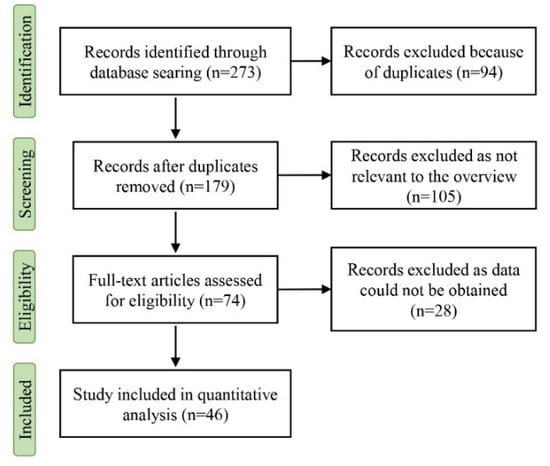
Figure 1.
Process of searching for and screening studies.
(i) The basic data of straw decomposition rate must be included or can be converted using the data in the study. (ii) The straw must be maize or wheat straw; (iii) The agronomic measures used must be clearly described; after filtering, 46 publications for the study on straw decomposition rate under agronomic measures were collected.
2.2. Database Construction
The research acquired data directly from text or tables in original papers or extracted data indirectly from figures using GetData software (version 2.22). If straw decomposition rates are not shown directly in the literature, the decomposition rate formula is as follows:
M0 means the quality of the straw before decomposition; Mt means the quality of the straw after decomposition.
Agronomic measures in all publications can be categorized into the following: (i) with plastic film-mulched or un-mulched; (ii) the crushing degree of straw, e.g., crushed, stubble or whole straw; (iii) tillage methods, e.g., turn-over, rotary tillage, subsoiling, no-plowing, deep plowing, turn-over plus rotary tillage or shifting agriculture; (iv) burial depth of straw; (v) the amount of nitrogen input; (vi) decomposition time; (vii) the amount of straw return. The number of entries or studies about decomposition rates under these influencing factors in this study is shown in Table 1.

Table 1.
Data on decomposition rates under different agronomic measures.
2.3. Data Analysis
All data were collected and analyzed using Microsoft Excel 2016. Figures were plotted in the Origin 2021 professional version. To calculate the significant difference in straw decomposition rates among agronomic measures, the one-way analysis of variance was utilized, followed by a least significant difference test function in the “Agricola” package in R software [28]. The random forest (“randomForest” (version 4.6-14) package in R software [29]) was utilized to rank the predictors in order of importance, following the method from references [30,31].
3. Analysis and Results
3.1. Effect of Decomposition Time on Straw Decomposition Rate
During the 375 days of the study, the range of decomposition rate of wheat straw was from 11.12% to 80.33%, with a median of 42.86% (Figure 2). However, in 84.1% of the studies, the study period of straw decomposition was mainly concentrated in 120 days, and the decomposition rate of wheat straw ranged between 11.12% and 78.06%, with a median of 40.80%. Additionally, the rapid decomposition period of wheat straw ranged from 0 to 30 days, with an average straw decomposition rate of 36.71%. Regression analysis shows that the decomposition rate of wheat straw was directly proportional to decomposition time (y = 0.1128x + 35.8075, R2 = 0.2586, p < 0.0001).
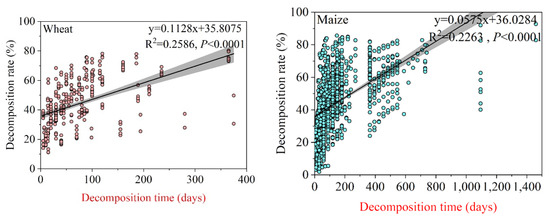
Figure 2.
Relationship between the decomposition rate of wheat or maize straw and decomposition time.
During the 1460 days of the study, the decomposition rate of maize straw ranged from 1.86% to 92.72%, with a median of 45.24% (Figure 2). In 81.1% of studies, the study period of maize straw decomposition concentrated in 180 days, and the decomposition rate was from 1.86% to 85.61%, with a median of 40.39%. Additionally, the rapid decomposition period was from 0 to 60 days, with an average straw decomposition rate of 31.80%. Regression analysis shows that the decomposition rate of maize straw was directly proportional to the decomposition time (y = 0.0575x + 36.0284, R2 = 0.2263, p < 0.0001).
3.2. Effect of Straw Return Modes on Straw Decomposition Rate
The decomposition rate of crushed wheat straw was 11.12–80.33% with a median of 41.85%, while the straw decomposition rate with stubble straw was 1.86–92.97% with a median of 46.90% (Figure 3). However, there was no significant difference between these two methods of straw return on the decomposition rate. For maize straw, the decomposition rate with crushed straw was 1.86–92.72% with a median of 45.58%, and those with whole straw were 5.84–56.82% with a median of 30.37%. Furthermore, a significant difference analysis illustrated that the decomposition rate of crushed maize straw was significantly increased compared with whole straw.

Figure 3.
Characteristics of the decomposition rate of wheat or maize straw with different return methods. Different letters within the same column indicate significant differences at p < 0.05 according to Duncan’s multiple range tests.
Additionally, there was a significant difference between the mulched and un-mulched states of straw in terms of the decomposition rate of wheat straw. Under the former treatment, the decomposition rate of wheat straw was 17.00–80.33% with a median of 60.63%, and that under the latter treatment was 11.2–78.06% with a median of 42.27%. However, there was no significant difference in the decomposition rate of maize straw between being mulched and not (Figure 4).
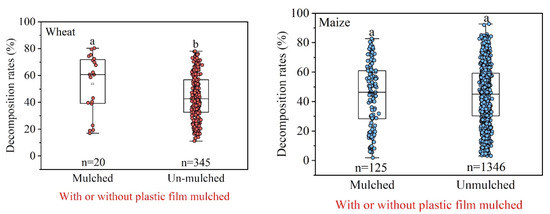
Figure 4.
Characteristics of the decomposition rate of wheat or maize straw with plastic film mulching. Different letters within the same column indicate significant differences at p < 0.05 according to Duncan’s multiple range tests.
3.3. Effect of Tillage Measures on Straw Decomposition Rate
For wheat straw return, no-plowing and turn-over are essential measures. The average decomposition rates of turn-over, rotary tillage, subsoiling and no-plowing were 42.74%, 37.27%, 36.63%, and 35.03%, respectively. However, there was not a significant difference among these four tillage measures in the decomposition rate of wheat straw. For maize straw return, there were seven types of tillage measures, among which turn-over and rotary tillage were important. The sequence of the straw decomposition rate was turn-over (52.20%) > rotary tillage (45.36%) > no-plowing (36.24%) > turn-over rotary tillage (34.43%) > deep plowing (32.80%) > subsoiling (32.22%) > shifting agriculture (29.93%). Significant difference analysis showed that the tillage measures significantly affected the decomposition rate of maize straw, and the straw decomposition rate in the turn-over and rotary tillage modes was significantly higher than that of the others (Figure 5).
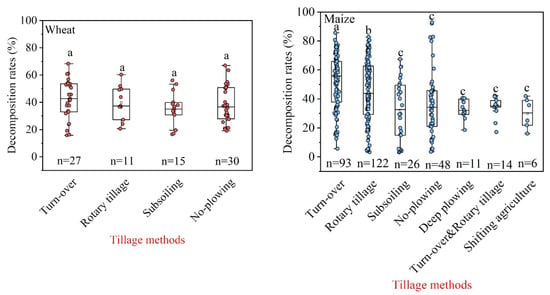
Figure 5.
Characteristics of the decomposition rate of wheat or maize straw in different tillage measures. Different letters within the same column indicate significant differences at p < 0.05 according to Duncan’s multiple range tests.
3.4. Effect of Burial Depth on Straw Decomposition Rate
The burial depth of wheat straw return was recorded for 0–25 cm, and the decomposition rate under each burial depth treatment was 0 cm (37.75%), 5 cm (34.64%), 7 cm (48.14%), 10 cm (49.18%), 15 cm (46.30%), 20 cm (68.53%), and 25 cm (39.37%), respectively. Regression analysis showed that the decomposition rate of wheat straw was directly proportional to burial depth (y = 0.4903x + 40.8365, R2 = 0.0319, p = 0.0005) (Figure 6). The coupling effect of the burial depth and the decomposition time of straw illustrated that, in the first 50 days, the straw decomposition rate reduced with the increase of burial depth, while the straw decomposition rate proliferated with the increase of burial depth during 50–120 days, and there was no correlation between them after 120 days (Figure 7).
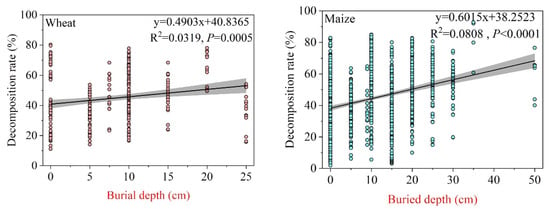
Figure 6.
Relationship between decomposition rate of wheat or maize straw and burial depth.
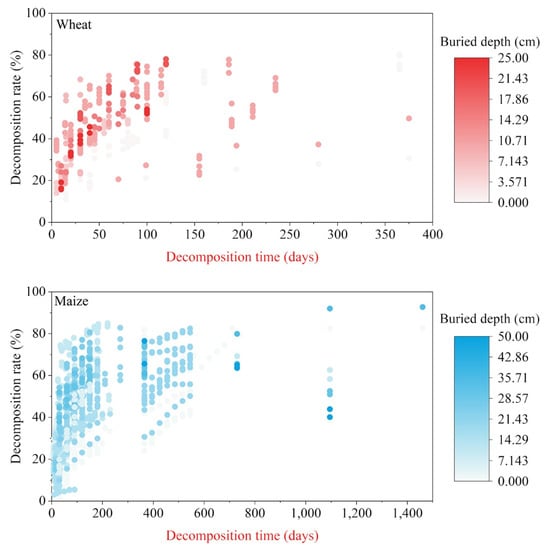
Figure 7.
Effect of burial depth and decomposition time on the decomposition rate of wheat or maize straw.
The burial depth of maize straw return was recorded for 0–50 cm, and the decomposition rate of straw under each burial depth treatment was 35 cm (85.94%), 50 cm (64.42%), 25 cm (56.54%), 10 cm (56.39%), 30 cm (54.30%), 20 cm (52.47%), 5 cm (38.08%), 15 cm (37.76%), and 0 cm (36.67%), respectively. Similar to wheat straw, the decomposition rate of maize was directly proportional to burial depth (y = 0.6015x + 38.2523, R2 = 0.0808, p = 0.0005) (Figure 6). The coupling effect of the burial depth of straw and the decomposition time showed that in 360 days, the straw decomposition rate proliferated with an increase in burial depth (Figure 7).
3.5. Effect of the Amount of Straw Return on the Straw Decomposition Rate
The amount of wheat straw return ranged from 1500 kg∙ha−1 to 8000 kg∙ha−1 in all studies, and the corresponding straw decomposition rate was from 11.12% to 80.33% with a median of 40.21%. However, there was no significant correlation between the straw decomposition rate and the amount of straw return (p > 0.05) (Figure 8). The coupling effect of the amount of straw return and the decomposition time showed that there was no significant correlation between the decomposition rate and the amount of wheat straw return at any stage of decomposition (Figure 9).
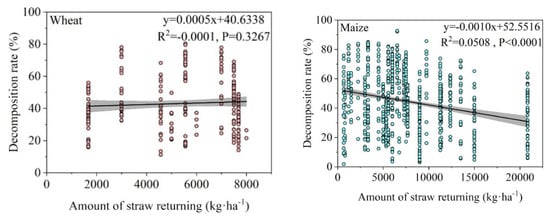
Figure 8.
Relationship between decomposition rate and the amount of straw return of wheat or maize straw.
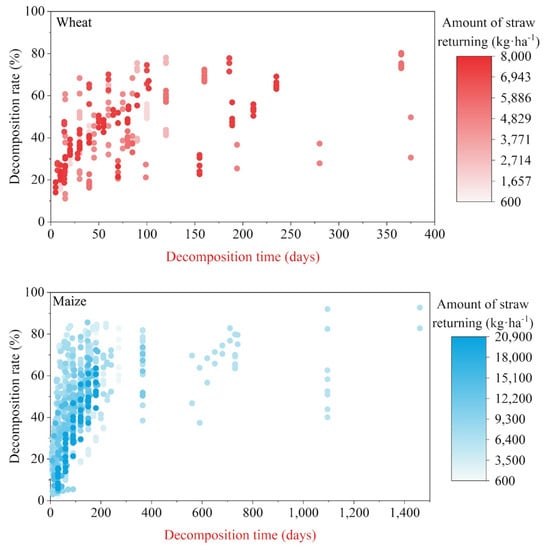
Figure 9.
Effect of the amount of straw return and decomposition time on the decomposition rate of wheat or maize straw.
The amount of maize straw return ranged from 675 kg∙ha−1 to 20,833.3 kg∙ha−1, and the corresponding straw decomposition rate was 1.86–92.72% with a median of 44.79%. Among them, the amount of straw return ranging from 6000–9000 kg∙ha−1 accounts for the majority, whose straw decomposition rate was 3.06–92.72% with a median of 46.32%. Nevertheless, the decomposition rate of maize straw was inversely proportional to the amount of straw return (y = −0.0010x + 52.5516, R2 = 0.0508, p < 0.0001) (Figure 8). The coupling effect of the amount of straw return and the decomposition time showed that in the first 200 days, the greater the amount of straw return, the lower the straw decomposition rate (Figure 9).
3.6. Effect of the Amount of Nitrogen on the Straw Decomposition Rate
For wheat straw return, the amount of nitrogen ranged from 0 to 810 kg∙ha−1, and the corresponding straw decomposition rate was 11.12–80.33% with a median of 44.93% (Figure 10). Statistics show that there was no correlation between wheat straw decomposition rate and the amount of nitrogen input (p > 0.05). The coupling effect of the amount of nitrogen input and the decomposition time of wheat straw demonstrated that the straw decomposition rate was relatively low when the nitrogen input was high in the early stage of decomposition, while there was no correlation between them in the late stage of decomposition (Figure 11).
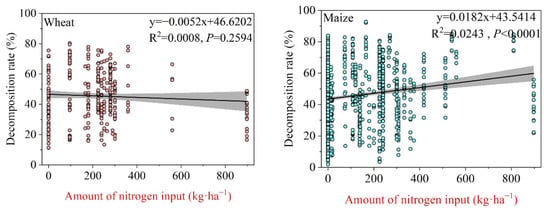
Figure 10.
Relationship between the decomposition rate of wheat or maize straw and the amount of nitrogen input.
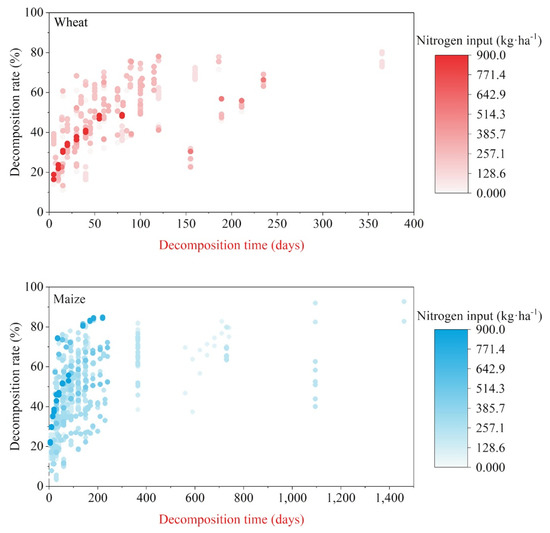
Figure 11.
Effect of nitrogen input and decomposition time on the decomposition rate of wheat or maize straw.
For maize straw return, the amount of nitrogen ranged from 0 to 897.75 kg∙ha−1, and the corresponding straw decomposition rate was from 1.86% to 92.97% with a median of 46.2%. Maize straw decomposition rate was significantly correlated with nitrogen input (y = 0.0182x + 43.54, R2 = 0.0243, p < 0.0001) (Figure 10). The coupling analysis of the amount of nitrogen input and the decomposition time of maize straw showed that in the early stage of decomposition, the increase in nitrogen input was helpful for the decomposition of maize straw; the more nitrogen input, the higher the decomposition rate, while there was no correlation between them in the late stage of decomposition (Figure 11).
4. Discussion
The study illustrated that the decomposition rate of maize straw was more significantly affected by agronomic measures. Crushed straw had comparatively higher decomposition rates, which is consistent with many studies [32]. This may be due to the destruction of the tissue structure of the straw crushed by crushing, which increases the contact area between the straw and the soil, consequently promoting straw decomposition not only by the soil microorganisms and enzymes but also due to the exchange of soil moisture and nutrients, thereby influencing the decomposition rate of the straw [33,34,35]. Similarly, other studies demonstrated that tillage treatments also impact maize straw decomposition rates, which affects the structure, as well as metabolic activity of soil microbial communities, delivering more favorable living conditions for microorganisms, thereby benefiting straw decomposition [14,36,37]. Furthermore, turn-over or rotary tillage methods have significant effects on soil ventilation and water permeability [20].
Straw contains considerable amounts of easily degradable organic matter. In the early stages of straw decomposition, microorganisms in soil can use easily degradable organic matter as a carbon source and energy for rapid growth. At this stage, nitrogen input treatment enables the straw to decompose rapidly and the straw decomposition rate accelerates [38,39]. With the extension of decomposition time, the perishable substances in straw gradually decreased, the proportion of refractory organic matter increased, and microbial activity decreased. Even with nitrogen input, the decomposition rate of straw will slow down [40]. Therefore, nitrogen input promoted straw decomposition significantly in the early stage of decomposition; however, during the process, the effect of nitrogen input on straw decomposition grew less significant.
Compared with maize straw, the decomposition rate of wheat straw was less affected by other agronomic measures besides the decomposition time and burial depth. Some studies have shown that the type of soil [41], rainfall and temperature [42], and biome composition [43] are the key factors that influence straw return [44]. During wheat straw return, a rise in temperature and abundant rainfall can result in improving microbial activity and promoting the straw decomposition rate. Zhang Lu [45] found in a study of the seasonal decomposition of wheat straw for consecutive years that high temperatures and high humidity are conducive to the decomposition of wheat straw.
A random forest analysis identified decomposition time as the most important predictor of straw decomposition rates for wheat and maize, especially for the latter (Figure 12). Straw decomposition takes time, and so does the growth of microorganisms. The decomposition of straw can promote an increase in the number of microorganisms, and the growth of microorganisms can also promote straw decomposition in turn [46]. China has successfully explored and proposed the localization of foreign conservation tillage technologies in a single cropping system [47]. However, in the wheat-maize double cropping system, research on agronomic measures and products in straw decomposition should be accelerated, such as the development of straw-decomposing agents and the development of farming machinery in line with China’s national conditions [48]. In addition, the amount of straw return was found to be a secondary factor affecting maize straw decomposition with random forest analysis. A higher amount of straw return can not only unbalance the soil carbon-nitrogen ratio but also reduce the growth of microorganisms if the soil is deficient in nitrogen, affecting straw decomposition rates [49,50]. Additionally, Xu et al. [51] found that the larger the amount of straw return, the higher the concentration of various organic acids and CO2 accumulated in a short period of time and the greater the harmful impact on the growth of the next crop. There is, therefore, a pressing need for the effects of the amount of maize straw return on the decomposition rate, crop yield and agricultural eco-environmental problems.

Figure 12.
Forest plot of the intensity of the influence of different influencing factors on the decomposition rate of wheat or maize straw.
5. Conclusions
Our statistical analysis of the effects of agricultural measures in wheat-maize rotation systems on straw decomposition rates reveals heterogeneity in the outcomes of experimental studies and identifies a significant influencer of this variation. Agricultural measures, such as crushing straws and burying them in soil with turn-over or rotary tillage measures, increase maize straw decomposition rates. The decomposition rates of maize straw are positively proportional to the changes in burial depth of maize straw in soil and nitrogen input proportional to the amount of straw return. Not surprisingly, there are fewer studies on the decomposition rate of wheat straw compared to maize straw. Analysis suggests that burial depth is one of the crucial factors for straw decomposition rate, compared to other agronomic measures. Additionally, decomposition time is one of the most important predictors of straw decomposition rates for wheat and maize. Some agronomic measures work together with decomposition time on straw decomposition. In general, agronomic measures are effective factors in controlling straw decomposition in a wheat-maize rotation system, but when overapplied, they can prove to be counterproductive. At present, China has implemented a variety of straw return models in line with local conditions, after thoroughly learning from straw return models from all over the world, making great contributions to China’s ecological development. Therefore, all countries should vigorously develop their own straw return modes while meticulously learning from the successful experiences of other countries to realize the effective utilization of straw resources worldwide.
Author Contributions
X.M., D.S. and M.M.: Writing—Original draft preparation, Data curation. H.L., S.L. and G.Z.: Investigation and Data curation. L.D., J.L.: Methodology, Writing—Reviewing and Editing. All authors have read and agreed to the published version of the manuscript.
Funding
This research was funded by the Beijing Municipal Natural Science Foundation (Grant No. 8202020), the National Natural Science Foundation of China (Grant No. 41907078) and the Science and technology project in Institute of Plant Nutrition, Resources and Environment, Beijing Academy of Agriculture and Forestry Sciences (Grant No. YZS201904, YZS202007).
Institutional Review Board Statement
Not applicable.
Informed Consent Statement
Not applicable.
Data Availability Statement
Data available in a publicly accessible repository. The data presented in this study are available on request from the author.
Acknowledgments
We thank the anonymous reviewers and the editors for their very helpful comments and suggestions for the manuscript.
Conflicts of Interest
The authors declare that they have no known competing financial interest or personal relationships that could have appeared to influence the work reported in this paper.
References
- Zhang, G.; Lu, F.; Zhao, H.; Yang, G.B.; Wang, X.K.; Yang, Z.Y.O. Residue usage and farmers′ recognition and attitude toward residue retention in China′s croplands. J. Agro-Environ. Sci. 2017, 36, 981–988. (In Chinese) [Google Scholar]
- Liang, W.; Nie, Y. Comprehensive utilization of crop straw: Foreign experience and Chinese countermeasures. World Agric. 2017, 9, 34–38. [Google Scholar] [CrossRef]
- Wang, X.-B.; Cai, D.-X.; Hoogmoed, W.B.; Oenema, O.; Perdok, U.D. Potential effect of conservation tillage on sustainable land use: A review of global long-term studies. Pedosphere 2006, 16, 587–595. [Google Scholar] [CrossRef]
- Yang, W.; Li, X.; Zhang, Y. Research Progress and the Development Trend of the Utilization of Crop Straw Biomass Resources in China. Front. Chem. 2022, 10, 904660. [Google Scholar] [CrossRef]
- Zeng, L.; Zhang, X.; Zhang, S.Q.; Wang, X.B.; Liang, G.Q.; Zhou, W.; Ai, C.; Zhang, Y.Q. Characteristics of decomposition, nutrient release and structure change of wheat straw in a fluvo-aquic soil under different nitrogen application rates. Plant Nutr. Fertil. Sci. 2020, 26, 1565–1577. (In Chinese) [Google Scholar]
- Ma, Y.L.; Shi, H.K.; Zhang, S.K.; Lv, R.H. Whole maize straw addition: The changes of soil physical and chemical properties and the effect on winter wheat. J. China Agric. Univ. 2003, 42–46. (In Chinese) [Google Scholar]
- Wang, H.P.; Jing, D.X.; Zhou, R.J.; Bo, J.F. Effects of maize straw returning amounts on soil characteristics, straw decomposition and corn sheath blight. J. Maize Sci. 2018, 26, 160–164+169. [Google Scholar] [CrossRef]
- Ding, Y.L. Effects of Different Straw Return Methods on Soil Biological Properties. Master’s thesis, Northwest A & F University, Xianyang, China, 2013. [Google Scholar]
- Blanco-Canqui, H.; Lal, R. Soil structure and organic carbon relationships following 10 years of wheat straw management in no-till. Soil Tillage Res. 2007, 95, 240–254. [Google Scholar] [CrossRef]
- Wang, X.; Lu, B.L.; Che, Z.X.; Zhang, J.D.; Bao, X.G.; Wu, K.X.; Cui, H. Effects of straw comminution and mulching on soil ammonia volatilization during corn nitrogen topdressing. Agric. Res. Arid Areas 2021, 39, 179–184. (In Chinese) [Google Scholar]
- Gao, N.N. The significance and utilization of crop straw returned to the field. Agric. Henan 2016, 15. [Google Scholar] [CrossRef]
- Zhang, C.X.; Hang, Y.W.; Li, F.J.; Zhu, X.K.; Li, C.Y.; Ding, J.F.; Zhu, M.; Guo, W.S. Effects of rice straw returning and nitrogen fertilizer on seedling emergence and morphological and physiological characteristics of wheat. J. Nucl. Agric. Sci. 2020, 34, 1805–1813. [Google Scholar] [CrossRef]
- Chi, C.; Ma, W.; Sha, H.L.; Li, S.H. Corn straw return field organic material humus dosage screening test. Mod. Agric. Sci. Technol. 2021, 140–141. [Google Scholar] [CrossRef]
- Sun, Z.; Bi, J.; Xia, G.L.; Zhu, G.L.; Shi, G.F.; Dong, H. Study of characteristic of nutrient releasing of maize straw with two tillage methods. Chin. Agric. Sci. Bull. 2014, 30, 133–136. (In Chinese) [Google Scholar]
- Cai, L.J.; Zhang, J.T.; Liu, J.Q.; Gai, Z.J.; Zhao, G.F.; Zhang, W.; GONG, Z.P.; MA, C.M. Effects of corn stalk amount returning to field on the soil nutrient and soybean yields under alternate year no-till corn-soybean rotation. Crops 2015, 5, 107–110. [Google Scholar] [CrossRef]
- Li, X.J.; Zhang, Z.G.; Li, Y.X. Effect of soil depth on decay speed of straw. Acta Pedol. Sin. 2001, 135–138. (In Chinese) [Google Scholar]
- Li, P.; Li, Y.C.; Shi, J.L.; Zheng, X.Q.; Wu, G.G.; JIang, W.; Zhao, K.; Ming, F.; Pan, A.H.; Lv, W.; et al. Rice straw return of different decomposition days altered soil fungal community structure. Acta Ecol. Sin. 2017, 37, 4309–4317. (In Chinese) [Google Scholar]
- Zhao, C.; Cao, Y.F.; Liu, K.; Xue, Q.H.; Lv, J.L. Characteristics of decomposition and variation of material composition of corn straw in laboratory simulation experiment. Agric. Res. Arid Areas 2014, 32, 183–186. (In Chinese) [Google Scholar]
- Zheng, D. The Nutrient Releasing Regularity of Crop Stalks under Different Conditions. Master’s Thesis, Northeast Agricultural University, Harbin, China, 2012. [Google Scholar]
- Wu, J.; Guo, X.S.; Lu, J.W.; Wan, S.X.; Wang, Y.Q.; Xu, Z.Y.; Zhang, X.L. Decomposition characteristics of rapeseed and wheat straws under different rice cultivations and straw mulching models. Acta Ecol. Sin. 2013, 33, 565–575. (In Chinese) [Google Scholar]
- Kuang, E.J.; Chi, F.Q.; Su, Q.R.; Zhang, J.M.; Jin, L. Decomposition characteristics of maize straws under different returning methods. J. Maize Sci. 2012, 20, 99–101. [Google Scholar] [CrossRef]
- Zhang, Y.; Chen, F.; Zhang, H.L.; Chen, J.K. Tillage effects of decomposed ratio on corn straw. J. Maize Sci. 2009, 17, 68–73. (In Chinese) [Google Scholar]
- Gao, S.M. Effects of Tillage and Nitrogen Fertilizer on Soil Physical and Chemical Properties, Microorganisms and Straw Decomposition Master; Northwest A & F University: Xianyang, China, 2021. [Google Scholar]
- Gong, X.J.; Qian, C.R.; Cao, X.; Yu, Y.; Hao, Y.B.; LI, L.; Ge, X.L.; Jiang, Y.B. Effects of Nitrogen Fertilizer on Soil Enzymatic Activity, Soil Nutrients and Decomposition Rate of Maize Straw. J. Maize Sci. 2020, 28, 151–155. [Google Scholar] [CrossRef]
- Li, C.M.; Wang, X.Y.; Sun, B. Characteristics of nutrient release and its affecting factors during plant residue decomposition under different climate and soil conditions. Acta Pedol. Sin. 2017, 54, 1206–1217. (In Chinese) [Google Scholar]
- Chen, J.Y.; Luo, C.Y.; Qiu, H.Z.; Deng, D.L.; Zhang, C.H.; GUo, Y.J.; Zhang, J.B. Effects of application of different nitrogen levels on decomposition characteristics and nutrient release of returning straw. Agric. Res. Arid Areas 2020, 38, 101–106. (In Chinese) [Google Scholar]
- Pang, L.D. Decomposition Rate of Corn Straw Returning and its Effects on Soil Nutrients. Master’s Thesis, Northeast Agricultural University, Harbin, China, 2017. [Google Scholar]
- Mendiburu, F. Statistical Procedures for Agricultural Research1.1-4. 2019. Available online: https://CRAN.R-project.org/package=agricolae (accessed on 30 March 2022).
- Breiman, L.; Cutler, A. Random Forests for Classification and Regression. R Package Version 4.6-12. 2015. Available online: https://www.stat.berkeley.edu/~breiman/RandomForestsCRAN.R-project.org/package=agricolae (accessed on 30 March 2022).
- Terrer, C.; Jackson, R.B.; Prentice, I.C.; Keenan, T.F.; Kaiser, C.; Vicca, S.; Fisher, J.B.; Reich, P.B.; Stocker, B.D.; Hungate, B.A.; et al. Nitrogen and phosphorus constrain the CO2 fertilization of global plant biomass. Nat. Clim. Change 2019, 9, 684. [Google Scholar] [CrossRef]
- Liaw, A.; Wiener, M. Classification and regression by randomForest. R News 2002, 3, 18–22. [Google Scholar]
- Huang, R.J.; Pan, M.A.; Yuan, T.Z.; Yuan, X.C.; Shen, Y.M. Study on Effect Under Different Straws Incorporation Methods. Anhui Agric. 2012, 233–234. (In Chinese) [Google Scholar]
- Nong, C.J.; Wang, Y.Y.; Xu, Z.; Xu, J.H.; Liu, Y.M.; Hong, Y.; Tang, L.; Zhang, F.B. Effect of organic matter-decomposition inoculant on maize and rice straw returning. Acta Agric. Boreali-Occident. Sin. 2016, 25, 34–41. (In Chinese) [Google Scholar]
- Wang, G.D. Study on Characteristics of Soil Decomposition and Functional Diversity of Microbial Communities Using Straw Returning Method. Master’s Thesis, Northeast Agricultural University, Harbin, China, 2018. [Google Scholar]
- Liu, Y.H.; Wang, S.L.; Li, J.P.; Qin, D.L.; Zhang, M.L.; Nie, J.J.; Mao, L.L.; Song, X.L.; Sun, X.Z. Effects of cotton straw returning soil on soil microbes quantites and enzyme activities. Acta Agric. Boreali-Sin. 2016, 31, 151–156. (In Chinese) [Google Scholar]
- Tian, P.; Jiang, Y.; Sun, Y.; Ma, Z.Q.; Sui, P.X.; Nan, M.; Hua, Q. Effect of straw return methods on maize straw decomposition and soil nutrients contents. Chin. J. Eco-Agric. 2019, 27, 100–108. [Google Scholar] [CrossRef]
- Xie, T.T.; Xiao, H.J.; Chen, Y.M.; Hu, G.; Qin, S.; Zhao, L.X.; He, C.X.; Zhao, H. Effects of straw returning to field and tillage on nutrient accumulation, use efficiency and yield component factors of spring maize in Guizhou province. Southwest China J. Agric. Sci. 2022, 35, 1056–1062. (In Chinese) [Google Scholar]
- Zhang, H.; Lv, J.L.; Cao, Y.F.; Xu, W.X. Effect of deep vertical rotary tillage on microbial community in sugar cane soil. Acta Pedol. Sin. 2014, 51, 743–752. (In Chinese) [Google Scholar]
- Cao, Y.F.; Zhang, H.; Liu, K.; Dai, Y.C.; Lv, J.L. Organic acids variation in plant residues and soils among agricultural treatments. Agron. J. 2015, 107, 2171–2180. (In Chinese) [Google Scholar] [CrossRef]
- Wang, N.; Li, P.; Zong, Y.Z.; Zhang, D.S.; Hao, X.Y. Study on the decomposition mechanism of wheat straw on rain-fed croplands in northern china under different patterns of straw returning practice. Acta Agric. Nucleatae Sin. 2020, 34, 1613–1619. (in Chinese). [Google Scholar]
- Vesterdal, L. Influence of soil type on mass loss and nutrient release from decomposing foliage litter of beech and Norway spruce. Can. J. For. Res. 1999, 29, 95–105. [Google Scholar] [CrossRef]
- Aerts, R. Climate, Leaf Litter Chemistry and Leaf Litter Decomposition in Terrestrial Ecosystems: A Triangular Relationship. Oikos 1997, 79, 439–449. [Google Scholar] [CrossRef]
- Cleveland, C.C.; Reed, S.C.; Keller, A.B.; Nemergut, D.R.; O’Neill, S.P.; Ostertag, R.; Vitousek, P.M. Litter quality versus soil microbial community controls over decomposition: A quantitative analysis. Oecologia 2014, 174, 283–294. [Google Scholar] [CrossRef]
- Gupta, S.R.; Singh, J.S. The effect of plant species, weather variables and chemical composition of plant material on decomposition in a tropical grassland. Plant Soil 1981, 59, 99–117. [Google Scholar] [CrossRef]
- Zhang, L. The Effect of Wheat Straw Stalks on Vegetable and Soil Properties by Soil-Covered in Facility. Master’s Thesis, The Yangzhou University, Yangzhou, China, 2019. [Google Scholar]
- Zhang, Y.J.; Ma, P.; Wang, Z.Q.; Yang, Z.Y.; Sun, Y.J.; Ma, J. Water-nitrogen coupling influence on rhizosphere environment and root morphology of rice under wheat straw return. Chin. J. Eco-Agric. 2022, 30, 924–936. (In Chinese) [Google Scholar]
- Liu, Y.Q.; Liu, Q.P. Research status and development trend of conservation tillage technology. Farm Mach. Using Maint. 2013, 7, S345. [Google Scholar] [CrossRef]
- Li, Q.Y.; Jia, X.D. Status quo and development trend of conservation tillage technology. J. Agric. Mech. Res. 2006, 11, 71–77. [Google Scholar] [CrossRef]
- Zhang, P.; Wei, T.; Li, Y.; Wang, K.; Jia, Z.; Han, Q.; Ren, X. Effects of straw incorporation on the stratification of the soil organic C, total N and C:N ratio in a semiarid region of China. Soil Tillage Res. 2015, 153. [Google Scholar] [CrossRef]
- Zhou, D.X.; Wang, G.D.; Wu, X.H.; Li, J.; Jin, C.M.; Wang, E.Z. Microbial community diversity and nutrient release of straws under different straw returning amounts. Chin. J. Soil Sci. 2018, 49, 848–855. [Google Scholar] [CrossRef]
- Xu, G.W.; Zhai, Z.H.; Chen, K.; Wang, H.Z.; Li, Y.J. Effects of different amounts of wheat-residue application on growth of direct-seeding rice. Guangdong Agric. Sci. 2015, 42, 1–6. [Google Scholar] [CrossRef]
Publisher’s Note: MDPI stays neutral with regard to jurisdictional claims in published maps and institutional affiliations. |
© 2022 by the authors. Licensee MDPI, Basel, Switzerland. This article is an open access article distributed under the terms and conditions of the Creative Commons Attribution (CC BY) license (https://creativecommons.org/licenses/by/4.0/).